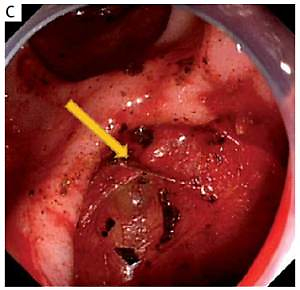Current issue
Archive
Manuscripts accepted
About the Journal
Editorial office
Editorial board
Section Editors
Abstracting and indexing
Subscription
Contact
Ethical standards and procedures
Most read articles
Instructions for authors
Article Processing Charge (APC)
Regulations of paying article processing charge (APC)
GASTROENTEROLOGY / CLINICAL RESEARCH
The role of periampullary diverticulum on the incidence
of pancreaticobiliary diseases and the outcome
of endoscopic retrograde cholangiopancreatography
1
The First Affiliated Hospital of Nanchang University, Nanchang, China
Submission date: 2018-03-03
Final revision date: 2018-08-03
Acceptance date: 2018-08-19
Online publication date: 2020-04-22
Publication date: 2021-07-16
Arch Med Sci 2021;17(4):905-914
KEYWORDS
biliary calculicomplicationscommon bile ductendoscopicretrograde cholangiopancreatographyperiampullary diverticulum
TOPICS
ABSTRACT
Introduction:
Periampullary diverticulum (PAD), although commonly discover¬ed in patients undergoing endoscopic retrograde cholangiopancreatograp¬hy (ERCP), remains controversial regarding its role in pancreaticobiliary diseases and the failure rate of cannulation. The aim of this study was to evaluate the association of PAD with pancreaticobiliary diseases and its impact on the outcome of ERCP.
Material and methods:
A retrospective analysis was carried out on 1455 patients who underwent an ERCP. Patients were divided into a PAD group and a control group without PAD, and propensity score matching was performed to adjust for clinical differences. The comparison was focused on pancreaticobiliary diseases, technical success, and complications of ERCP.
Results:
The occurrence of PAD is associated significantly with increasing age (p < 0.001). Incidences of acute pancreatitis (AP), suppurative cholangitis, and pancreatic head cancer were significantly higher in the PAD group (p < 0.05). After propensity score matching, the PAD group exhibited a higher rate of post-ERCP complications including haemorrhage, post-ERCP pancreatitis (PEP), and hyperamylasaemia (p < 0.05). However, the prevalence of perforation and the success rate of ERCP did not differ between groups (p > 0.05).
Conclusions:
Periampullary diverticulum develops with aging and seems to be associated with an increase in pancreaticobiliary diseases and post-ERCP complications except for perforation. Additionally, the presence of PAD does not affect the technical success of ERCP.
Periampullary diverticulum (PAD), although commonly discover¬ed in patients undergoing endoscopic retrograde cholangiopancreatograp¬hy (ERCP), remains controversial regarding its role in pancreaticobiliary diseases and the failure rate of cannulation. The aim of this study was to evaluate the association of PAD with pancreaticobiliary diseases and its impact on the outcome of ERCP.
Material and methods:
A retrospective analysis was carried out on 1455 patients who underwent an ERCP. Patients were divided into a PAD group and a control group without PAD, and propensity score matching was performed to adjust for clinical differences. The comparison was focused on pancreaticobiliary diseases, technical success, and complications of ERCP.
Results:
The occurrence of PAD is associated significantly with increasing age (p < 0.001). Incidences of acute pancreatitis (AP), suppurative cholangitis, and pancreatic head cancer were significantly higher in the PAD group (p < 0.05). After propensity score matching, the PAD group exhibited a higher rate of post-ERCP complications including haemorrhage, post-ERCP pancreatitis (PEP), and hyperamylasaemia (p < 0.05). However, the prevalence of perforation and the success rate of ERCP did not differ between groups (p > 0.05).
Conclusions:
Periampullary diverticulum develops with aging and seems to be associated with an increase in pancreaticobiliary diseases and post-ERCP complications except for perforation. Additionally, the presence of PAD does not affect the technical success of ERCP.
Share
RELATED ARTICLE
We process personal data collected when visiting the website. The function of obtaining information about users and their behavior is carried out by voluntarily entered information in forms and saving cookies in end devices. Data, including cookies, are used to provide services, improve the user experience and to analyze the traffic in accordance with the Privacy policy. Data are also collected and processed by Google Analytics tool (more).
You can change cookies settings in your browser. Restricted use of cookies in the browser configuration may affect some functionalities of the website.
You can change cookies settings in your browser. Restricted use of cookies in the browser configuration may affect some functionalities of the website.



